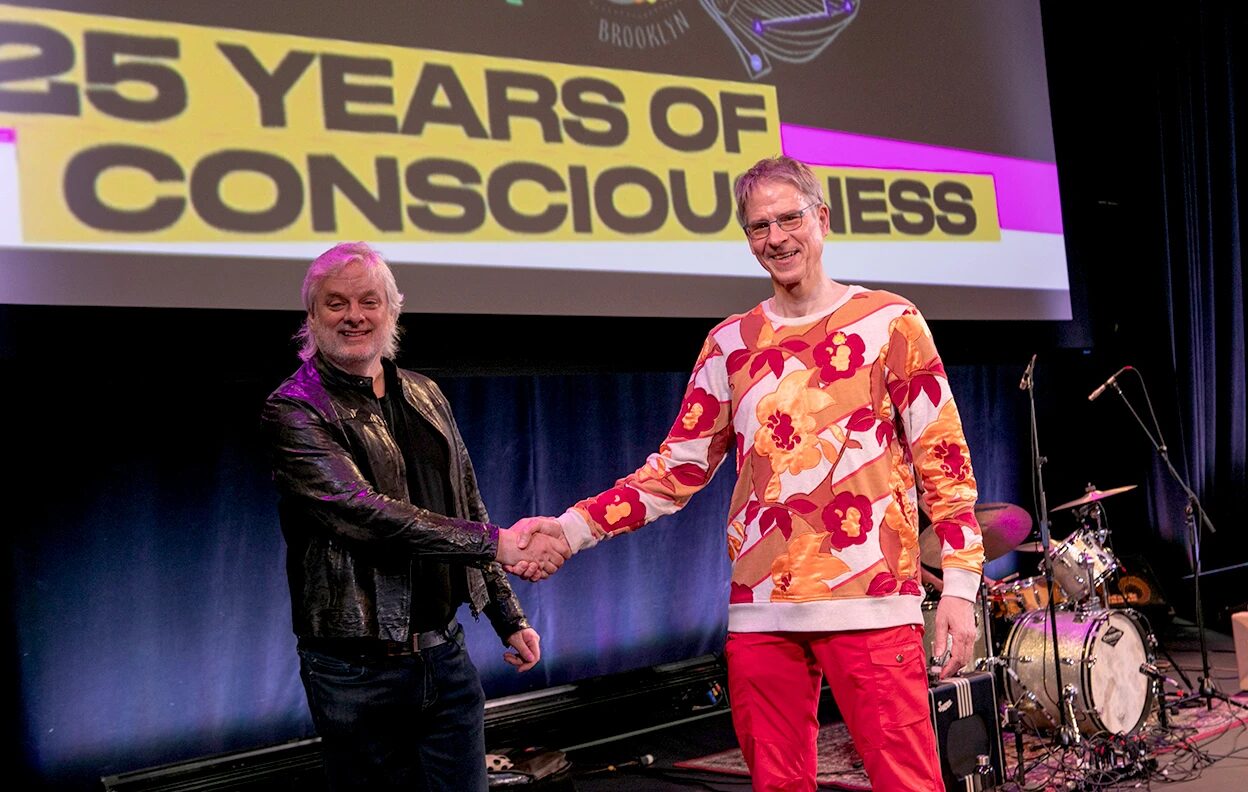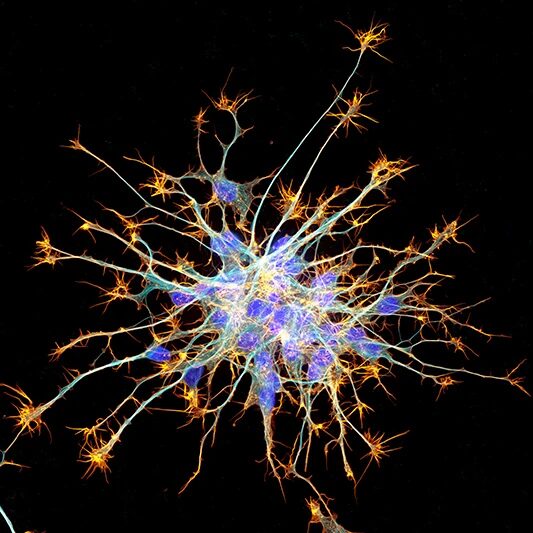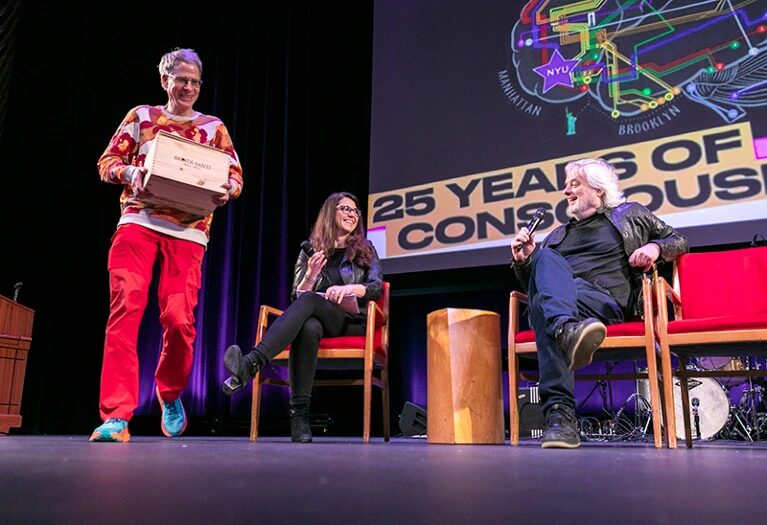
What ultimately helped to settle the bet was a key study testing two leading hypotheses about the neural basis of consciousness, whose findings were unveiled at the conference.
"It was always a relatively good bet for me and a bold bet for Christof," says Chalmers, who is now co-director of the Center for Mind, Brain and Consciousness at New York University. But he also says this isn't the end of the story, and that an answer will come eventually: "There's been a lot of progress in the field."
The great wager
Consciousness is everything a person experiences — what they taste, hear, feel and more. It is what gives meaning and value to our lives, Chalmers says.
Despite a vast effort — and a 25-year bet — researchers still don't understand how our brains produce it, however. "It started off as a very big philosophical mystery," Chalmers adds. "But over the years, it's gradually been transmuting into, if not a 'scientific' mystery, at least one that we can get a partial grip on scientifically."
Koch, a meritorious investigator at the Allen Institute for Brain Science in Seattle, Washington, began his search for the neural footprints of consciousness in the 1980s. Since then, he has been invested in identifying "the bits and pieces of the brain that are really essential — really necessary to ultimately generate a feeling of seeing or hearing or wanting," as he puts it.
At the time Koch proposed the bet, certain technological advancements made him optimistic about solving the mystery sooner rather than later. Functional magnetic resonance imaging (fMRI), which measures small changes in blood flow that occur with brain activity, was taking laboratories by storm. And optogenetics — which allowed scientists to stimulate specific sets of neurons in the brains of animals such as nonhuman primates — had come on the scene. Koch was a young assistant professor at the California Institute of Technology in Pasadena at the time. "I was very taken by all these techniques," he says. "I thought: 25 years from now? No problem."
Adversarial collaboration
For many years, the bet was mostly forgotten. That is, until a few years ago, when it was resurfaced by Per Snaprud, a science journalist based in Stockholm who had interviewed Chalmers back in 1998. His recording of the chat reminded the pair of the terms they had set in the wager and the case of wine that was at stake.

The goal was to set up a series of 'adversarial' experiments to test various hypotheses of consciousness by getting rival researchers to collaborate on the studies' design. "If their predictions didn't come true, this would be a serious challenge for their theories," Chalmers says.
The findings from one of the experiments — which involved several researchers, including Koch and Chalmers — were revealed on Friday at the ASSC meeting. It tested two of the leading hypotheses: Integrated information theory (IIT) and global network workspace theory (GNWT). IIT proposes that consciousness is a 'structure' in the brain formed by a specific type of neuronal connectivity that is active for as long as a certain experience, such as looking at an image, is occurring. This structure is thought to be found in the posterior cortex, at the back of the brain. On the other hand, GNWT suggests that consciousness arises when information is broadcast to areas of the brain through an interconnected network. The transmission, according to the theory, happens at the beginning and end of an experience and involves the prefrontal cortex, at the front of the brain.
Six independent laboratories conducted the adversarial experiment, following a pre-registered protocol and using various complementary methods to measure brain activity. The results — which haven't yet been peer-reviewed — didn't perfectly match either of the theories.
"This tells us that both theories need to be revised," says Lucia Melloni, a neuroscientist at the Max Planck Institute for Empirical Aesthetics in Frankfurt, Germany, and one of the researchers involved. But "the extent of that revision is slightly different for each theory".
Unfulfilled predictions
"With respect to IIT, what we observed is that, indeed, areas in the posterior cortex do contain information in a sustained manner," Melloni says, adding that the finding seems to suggest that the 'structure' postulated by the theory is being observed. But the researchers didn't find evidence of sustained synchronization between different areas of the brain, as had been predicted.

So GNWT fared a bit worse than IIT during the experiment. "But that doesn't mean that IIT is true and GNWT isn't," Melloni says. What it means is that proponents need to rethink the mechanisms they proposed in light of the new evidence.
Other experiments are underway. As part of the Templeton foundation initiative, Koch is involved in at study testing IIT and GNWT in the brains of animal models. And Chalmers is working on another project evaluating two other hypotheses of consciousness.
It's rare to have proponents of competing theories come together at the table and be open to having their predictions tested by independent researchers, Melloni says. "That took a lot of courage and trust from them." She thinks that projects like these are essential for the advancement of science.
As for the bet, Koch was reluctant to admit defeat but, the day before the ASSC session, he bought a case of fine Portuguese wine to honour his commitment. Would he consider another wager? "I'd double down," he says. "Twenty-five years from now is realistic, because the techniques are getting better and, you know, I can't wait much longer than 25 years, given my age."



Reader Comments
G od never existed, you are nothing but a sack of water and neurons. Life has no meaning except obeying your earthly masters, for we are God.
Too bad it will never happen ...
Some dogs think the other entity, not knowing this their own self, is an adversary.
Other dogs just know something else is there in their eyes....but they don't know about mirrors and such.
So you can't blame a dog being confounded when it looks in the mirror, but a human looks in the mirror wondering.....such a human ought ask itself - am I a puppet?
~
The honest answer might be yes . If it is, said human ought ponder to whom it is a puppet....who is pulling your strings said human ought wonder. That is the first step towards consciousness I reckon.
If you don't ask the right questions, the answers won't be found. Does consciousness exist outside of the body and brain?
The Orwellian approach to corrupt all language seriously muddles any serious discussion.
I remember reading about a student coming to a great biologist and asking him several questions. The biologist said, "I don't know. Come work in my laboratory and see."
The current academic system of grants where the grants are controlled by dogmatic silos of interest and direction, makes it difficult to be a scientist. You are dependent on funding. When I was in graduate school, one of the professors was an expert at writing grant proposals.
A: Ya can't count to infinity.
Q: Why won't they ever stop trying?
A: Materialism is an itch that can never be scratched.
Consciousness is an amazing "gift" to be aware.....
where it comes from is mystery!
Just like the love of your life.
Mysteries are what makes life worth living cause otherwise, you are just either a robot or a zombie or maybe both.
Robots and zombies are not conscious.....
otherwise, they wouldn't be a robot or a zombie....
Love is a good thing and love is the proof of consciousness.
Love is a mystery.
BK, Poem of the Day, 62723 1259
I just got back from Salem, MA and that image is sort of a "ringer"!
Nice to meet you.
BK
Why not share some more info about yourself besides just saying "sott.net" reader, but take that suggestion with a grain of salt and nice to meet you again!
BK
Hmm...
Yeadon, the former exec of Pfizer, indicated that in the beginning of the vaxx, BigPharma could not generate the vax at the scale (7 billion) necessary. He raised questions early on that quality control would be sacrificed, which it was.
When you think about adding a poison, like the vax, to water and that it would also affect human beings who drank the water, again doesn't understand the concentrations of the toxic agents in the vax vs the concentrations required for drinking water. That is also scale.
For example, the scale of the impact associated with the high concentration of small particulate ("PM2.5") in the air throughout the northeastern part of the US of A by virtue of fires in the forest in Canada is significant - tis a large-scale effect. It has harmed many. Moreover, the harm continues. Likewise, if plans are being made to harm a nuclear facility, the scale of that will be world-wide.
BK
I'm looking above rather than below.
I hold onto a thread that says wiser minds will prevail.
The concept of scale is so appealing in so many ways....
I mean you have Lady Libra holding the scale in balance...
and you have the scale of effect upon others.
Harmful effect, consciously inflicted upon others is criminal behavior....
and I have faith that Lady Libra knows this already.
She holds the scales in balance.
~
Peace to you Hmm... BK, Poem of the Day, 63023 1614 - I'm ready for this month to be over.....
BK
Who is behind it? Obviously the "global warming" climate psychopaths, who are really concerned that you don't drive a gasoline powered car.
Math cannot explain anything.
Math by itself is totally abstract. I would even go so far and call it intellectual self-gratification ...
I think this whole discussion is about topics we agree upon with the possible acception of the semantics around it all - semantics are not trivial and neither is math I reckon.
BK
But even if you thought you had a reason to give somebody a beating what makes you so sure they don't already know that and intend on defending themselves - so really - who can beat whom?
By the way, I got beets in my garden - what you got in yours?
Is it balanced?
Is it?
It does not explain something, but is an abstract form to note/register one's experience.
Like, add two apples to two other apples (though I prefer beer bottles - NOT Bud light !). And you get for. This is the way it is (or was, at least) teached to children - based on their experience with "things", being it apples, pencils, or cakes ...
I would characterize " math" as a mostly redundance-free symbolic "language". Very similiar to programming languages I use to deal with daily. Were every element (symbol, key word) was a specific meaning, and you can form arbitrarily complex expressions with it to describe arbitrarily complex systems. At least in theory ...
Still - some things are obvious and why not focus on those things for which we all ought agree.
Ken
I only wonder how modern "education" a.k.a. ideological brainwashing can convince people of obvious falsehoods that contradict their everyday reality. The fourty-something genders with birth-giving men are one example. But that "math doesn't matter and is social construct" is another one.
Such a society is doomed, I think ...
Before we discuss "math" further, I think we all ought come to terms on what the concept even means semantically....that way, we can be sure we are on the same page in discussion.
When it comes to translation from one language to another, I have a few ideas that I think might be helpful to improve that.
So - here is the definition of "math" from MW (it leads to "mathamatics"): [Link] I believe math can explain things in a way easier...
Ken
Though the application of statistics for a specific matter is the admission of incognizance of the underlying effect mechanism. While I can imagine that, this is not the case for me.
Bits and byte occasionally, and sometimes scantily dressed girls ...
Published in U.K. 1969 Allen and Unwin Ltd.
Published in USA 1972 Julian press If you can't find it (it's on most of the torrent sites) and would like a copy, I will get one to you.
Best,
Hmm...
[Link]
It only had 14 views when I checked it out.
I reckon that is a little bit of consciousness - or is it just random thought?
BK
[Link]
courtesy youtube
F*ck YT !
Sometimes I wonder if there are others; consciousnesses outside humanity's own, that are separate from ours, and I think there are. Sort of as in totemism, like a singular Spirit of the Wolf or Bear that travels through its body(s) at large, from generation to generation.
I think it is apparent that the dog will not pass its consciousness on to humans, but only unto its pups, and does, for example. Likewise the bird unto birds, fish unto fish, and each after it's own kind, as it were. I believe these traveling spirits are all of their own separate volition, as set apart and divided from the Breath of the One Great Spirit according to His likeness and design.
My hope is that we each expand it, cultivate it, garnish and decorate it, and then pass it on enriched...and to not offend the others (Wolf, Bear, and Eagle, etc) with it while we are here.That's embarrassing, I think, when we do.
The worst thing done to us humans is convince us - or at least some of us - we are all a bunch of atoms, arranged according to a blind watchmakers plan into a simple bio-machine. Some day it is all over, and that's all there is. Pure nihilistic materialism, in other words.
The universe is rightly difficult to describe with mere words or math, being filled with paradox and infinity and such, and I think maybe that's what poetry, dancing, and songs are for.
People need to just loosen up on the handle bars and enjoy the ride a little.
In ancient oriental times, Art and Science used to be united with one word: Yoga... the word in itself means unity.... as time has gone on, the terms have divided and multipled... Before, science was an all-uniting field... At root, the unifying language was numbers. Nowadays, an astronomer doesn't understand the psychologist, nor does the biologist comprehend the chemist.
I think Christianity ('Churchianity', to be more precise) did a great damage to our view of paganism. Today, we call them 'gods'... but in the past, they were perceived as beings living alongside our existence... They were obviously superior, but we never deified them or called them 'gods' (although the word 'god' originates from 'guard', which in a sense was a closer understanding of their otherworldly role.) Thanks to 'Churchianity', not only was a human being (Jesus) raised to the height of 'God', as compensation we began 'viewing' these older brothers and sisters as 'gods'... and consequently, separating ourselves from their direct influence. What we call 'paganism' today is really a knee-jerk reaction against Christianity... whilst not even knowing that our view has been poisoned by 'gods', we now do to these higher beings (calling them gods), exactly what the Church did to a human being (called him God)...
At root, it is all idolatry, and we still have no idea how much we unconsciously idolatrise the 'gods' of 'liberty', 'justice', 'intelligence', 'beauty'.
All comes from God... and all will return back to God.
Colonialist religiosity seemed to me determined to hang its flag on everything, and maybe more inclined to glorify the state religion than glorify God Himself. I think you're right. That caused a rift, one of many. Later day shit heads like Jim Jones didn't help either.
.